One of the reasons SEO is such an exciting space is that we’re constantly being challenged to innovate.
But that doesn’t mean you need to reinvent the wheel. That just isn’t scalable – especially not at the enterprise level.
You need to keep proven tactics in your back pocket that you can adapt and modify to inform your own SEO strategy.
And so I was wondering… what useful insights can we learn in studying the keywords that enterprise-level companies are optimizing for?
This is not an exhaustive study; rather, it’s a high-level view of known ranking factors such as links, content, and user experience.
There’s much to be learned from the brands that are winning in search!
In this column, you’ll learn a process for analyzing SERPs and find tips to improve your own SEO based on what we can see others doing well in Google results.
How I Chose The Keywords For This Assessment
Before we jump into the analysis, I want to share how the keywords were chosen.
First, I searched for a list of the top enterprise companies in the U.S.
An enterprise company is a large corporation with a very large marketing budget that manages thousands of employees – think Fortune 500 companies.
I picked out 21 sites I thought would return general keywords and avoided brand-specific keywords like “iPhone.”
Then, I used Ahrefs to see what organic keywords the sites were ranking for with a keyword difficulty score of 90 and above.
I sorted the list by traffic to the site because this tells me that the web page is most likely relevant to the user’s search query. Otherwise, they wouldn’t have clicked through.
At this point, I had a list of 44 possible keywords to study.
Next, I did a quick Google search to see if there was a variety of websites on the result’s page or if one type of website dominated.
This knocked out some contenders such as “weather,” for example, because it’s a given that the weather channel, national weather service, and new stations will rank.
Finally, I settled on three enterprise-level keywords that cover a broad range of business types:
- Retail (coffee).
- Service industry (life insurance).
- Fintech (NFT).
[Coffee] SERP Insights
The search engine result page (SERP) for the keyword “coffee” interested me because it’s so clean!
The SERP covers just about every possible search intent for the query, “coffee.”
And a few oddities caught my eye that may provide us further insight into how Google’s algorithm works.
This section will cover what makes “coffee” an enterprise SEO keyword with quick stats, jump into a review of what the SERP tells us, and lastly analyze the link profile and content to see what we can learn.
Coffee Keyword Stats
- Avg. Monthly Volume: 6.6 million in the United States.
- Difficulty Rating: 96.
- Average CPC: $1.80.
-
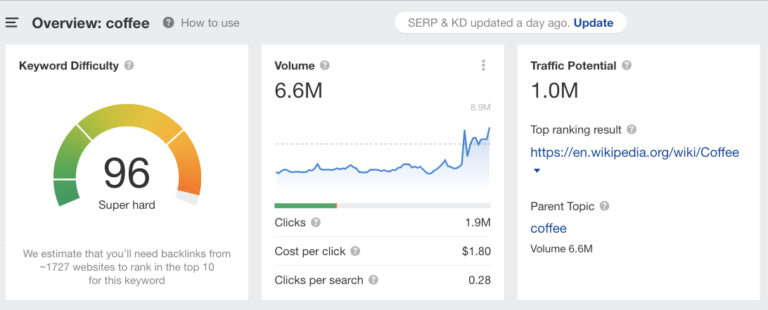 Screenshot from Ahrefs, May 2022
Screenshot from Ahrefs, May 2022
SERP Review
When you search “coffee,” you may see a carousel of shopping ads and a map of your local coffee shops.
You can read a knowledge panel with information from Wikipedia and nutrition facts sourced from the USDA on the right-hand side.
-
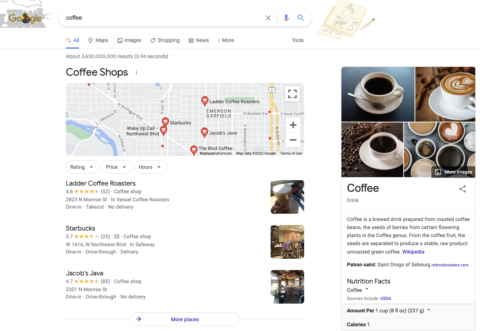 Screenshot from search for [coffee], Google, May 2022
Screenshot from search for [coffee], Google, May 2022
Followed by suggested searches for Starbucks coffee drinks, songs about coffee, and other items people often search for: tea, espresso, drink, etc.
We have Wikipedia, Peet’s Coffee, Coffee Bean & Tea Leaf, Starbucks, National Coffee Organization, and a healthline.com article in the traditional organic results.
-
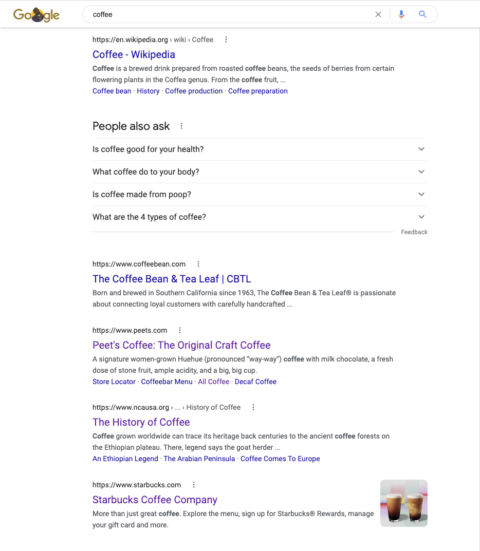 Screenshot from Google search, May 2022
Screenshot from Google search, May 2022
Hmmm, I wonder why Peet’s coffee ($7.9 billion in total sales) is beating Starbucks ($24.6 billion in net revenue).
And how did the healthline.com article squeak in there?
Let’s find out!
Links Review
Peet’s Coffee has 6,900 referring domains linking to the ranking page, while Starbucks has 4,900 referring domains linking to the home page.
-
 Screenshot from Ahrefs, May 2022
Screenshot from Ahrefs, May 2022
Peet’s Coffee has approximately 1,500 internal backlinks pointing to the ranking page.
440 of the 1,500 internal backlinks have the anchor or surrounding text, including “coffee.”
-
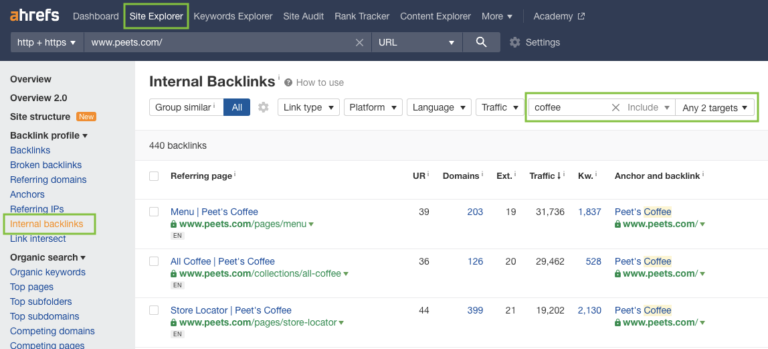 Screenshot from Ahrefs, May 2022
Screenshot from Ahrefs, May 2022
Starbucks has 13,400 internal backlinks to the ranking page; 9,600+ backlinks include “coffee” in the anchor or surrounding text.
-
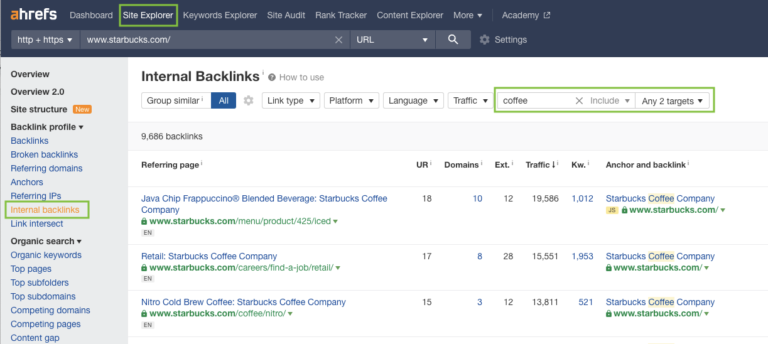 Screenshot from Ahrefs, May 2022
Screenshot from Ahrefs, May 2022
Content Review
Peet’s home page has “coffee” in the page title and as the first menu navigation item.
Subheaders cover the topic of coffee, from roasting to the history of coffee.
The word “coffee” is counted a total of 42 times on the home page, out of a total of 1283 words.
-
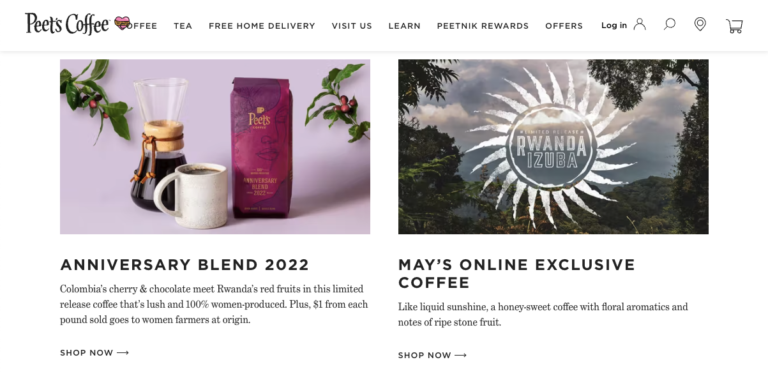 Screenshot from Peet’s Coffee home page, May 2022
Screenshot from Peet’s Coffee home page, May 2022
Starbucks, on the other hand, appears to use its website as an extension of its retail locations.
The home page really feels like an app to order coffee or a corporate communication board – like the digital version of a break room corkboard.
Coffee is in the page title as part of the brand’s name, but it is not the primary word on the home page.
Out of a total of 515 words, coffee is counted only 12 times.
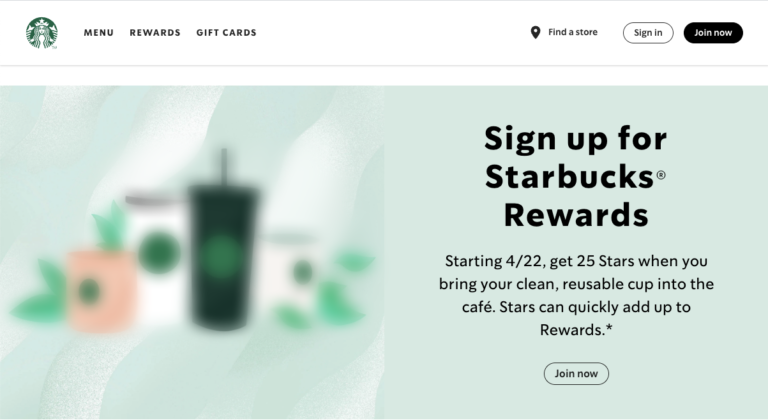 Screenshot from Starbucks home page, May 2022
Screenshot from Starbucks home page, May 2022Technical SEO/UX Review
I did not run a full technical audit for this analysis, so additional factors could be at play here.
I used a schema validator and Page Speed Insights tool to quickly assess what schema is on page and the specific web page’s core web vitals.
Peet’s Coffee uses organization, webSite, Product, and Store schema, and it failed the core web vitals assessment.
Primarily in first contentful paint (FCP) and largest contentful paint (LCP).
The first input delay (FID) and cumulative layout shift (CLS) look good.
 Screenshot from Web Core Vitals report, May 2022
Screenshot from Web Core Vitals report, May 2022Starbucks.com home page passes core web vitals in all four areas: FCP, LCP, FID, and CLS however, I did not detect any schema markup.
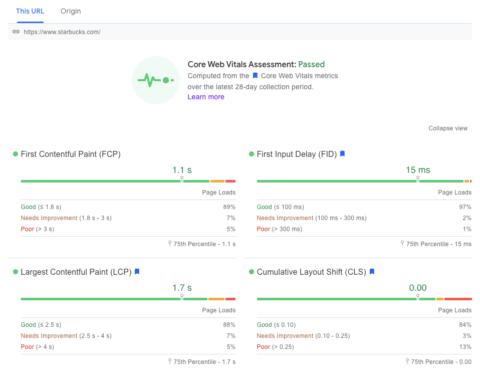 Screenshot from Web Core Vitals report, May 2022
Screenshot from Web Core Vitals report, May 2022It was interesting to see position history between May 2020 and April 2021. Starbucks seems to have fallen out of the top 100 for an entire year.
Did Starbucks get hit with a penalty?
-
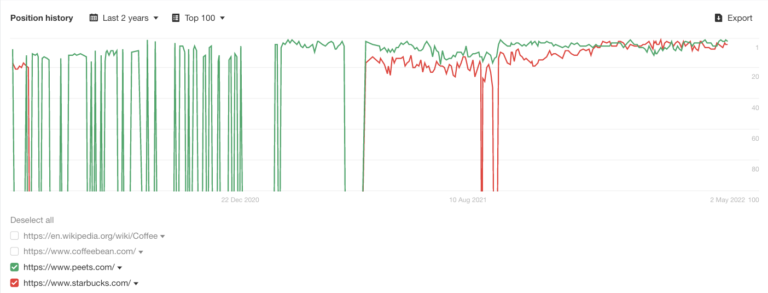 Screenshot from Ahrefs, May 2022
Screenshot from Ahrefs, May 2022
Breaking Into A Highly Competitive SERP
We have to talk about what Healthline did because it’s such a great example.
Healthline published an article, “9 Unique Benefits of Coffee,” on January 11, 2022, and began ranking in position 3 for the query “coffee” by March 04, 2022.
-
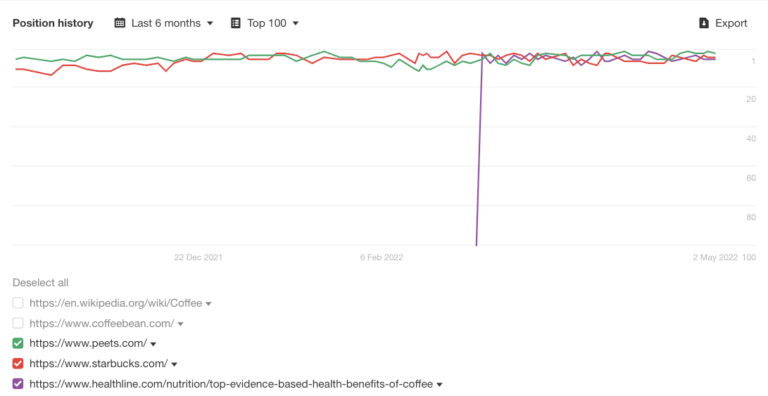 Screenshot from Ahrefs, May 2022
Screenshot from Ahrefs, May 2022
Wondering how Healthline found the wedge in?
They noticed the missing piece from the SERP.
The SERP covered shopping, local shops, definition, nutrition facts, songs, recipes, and videos but not why people would be interested in drinking coffee – the benefits.
The people also ask (PAA) questions provided a solid hint with questions like: “What are the benefits of coffee?” and “Is coffee good for your health?”
If you search for “coffee benefits” or “benefits of coffee”, the Healthline article leads as an unorganized list featured snippet.
-
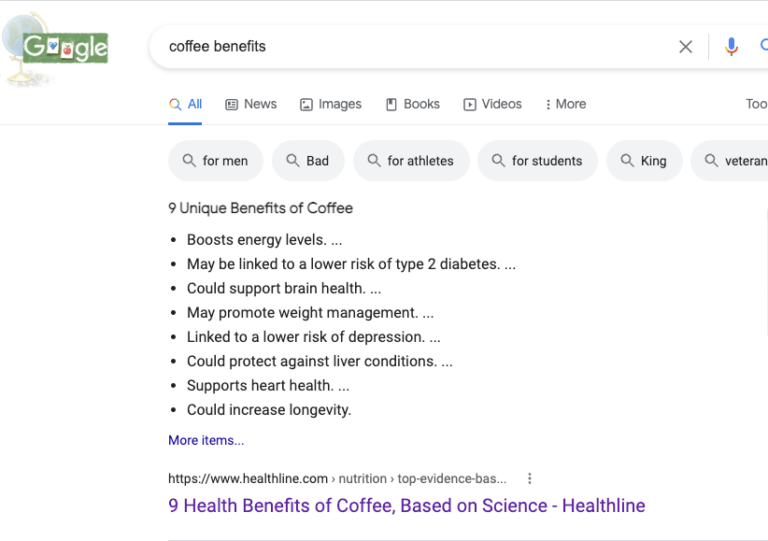 Screenshot from Google Search, May 2022
Screenshot from Google Search, May 2022
Outranking arguably more trusted websites like hopkinsmedicine.org, rush.edu, and harvard.edu.
YMYL sites should pay special attention to Healthline page structure and author profiles.
In the screenshot below, take note of how each sentence uses a “fact-checked” source, followed by a summary explaining it to readers in simple terms.
-
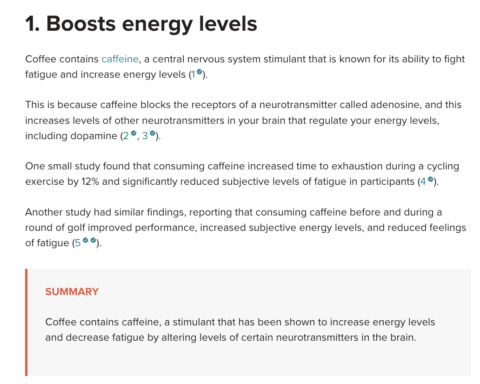 Screenshot from Healthline web page, May 2022
Screenshot from Healthline web page, May 2022
This is really well-written content.
One more thing – did you notice anything odd about when the Healthline article ranked?
Nearly two months passed between when the Healthline article was published and when the article ranked.
What gives?
Healthline went hard adding internal links to the “benefits of coffee” page in March 2022 (First seen March 2, 2022) – and pop – the article ranks!
“9 Unique Benefits of Coffee” currently has 266 internal backlinks; 247 include the term “coffee” in the anchor or surrounding text.
-
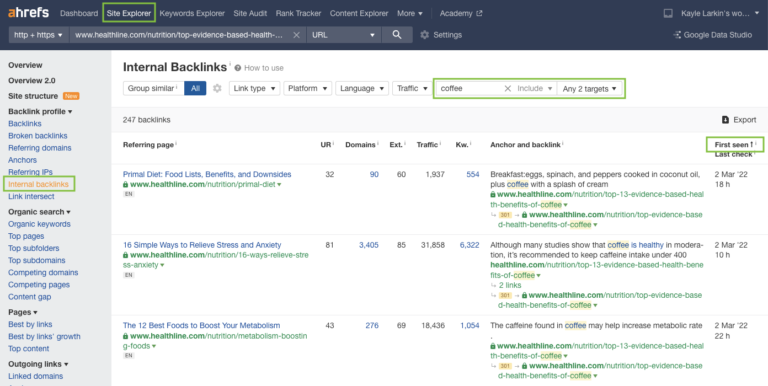 Screenshot from Ahrefs, May 2022
Screenshot from Ahrefs, May 2022
Coffee: What We Can Learn
By analyzing the entire SERP, we can see that Google is looking to cover every possible search intent for the very basic query of “coffee.”
While Peet’s Coffee, Coffeebean.com, and Starbucks seem to dance for the top company ranking for the query – healthline.com found an opportunity by focusing on what the SERP did not contain.
However, it seems like the Healthline article did not really gain footing until the site added internal backlinks to the article using the desired search query of “coffee.”
[Life Insurance] SERP Insights
Life insurance is an interesting SERP to study because it showcases the battle of big national brands with a seemingly unlimited marketing budget (if you look at CPC numbers) for what is a relatively lower search volume.
Analyzing “life insurance” is sure to turn out some gems.
Life Insurance Keyword Stats
- Average monthly search volume: 202k in the United States.
- Difficulty rating: 90.
- Average CPC: $30.
-
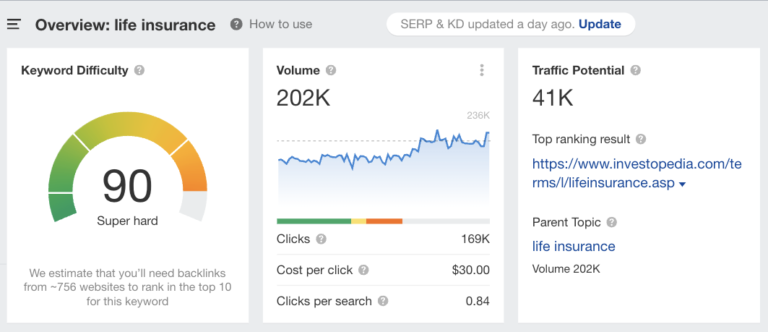 Screenshot from Ahrefs, May 2022
Screenshot from Ahrefs, May 2022 - SERP Review
When you google “life insurance” the recommended search terms are:
- Companies: Google understands who we are trying to reach.
- Quotes and policy: Google understands what we want from the company.
- For seniors: Google understands the primary target audience for life insurance.
-
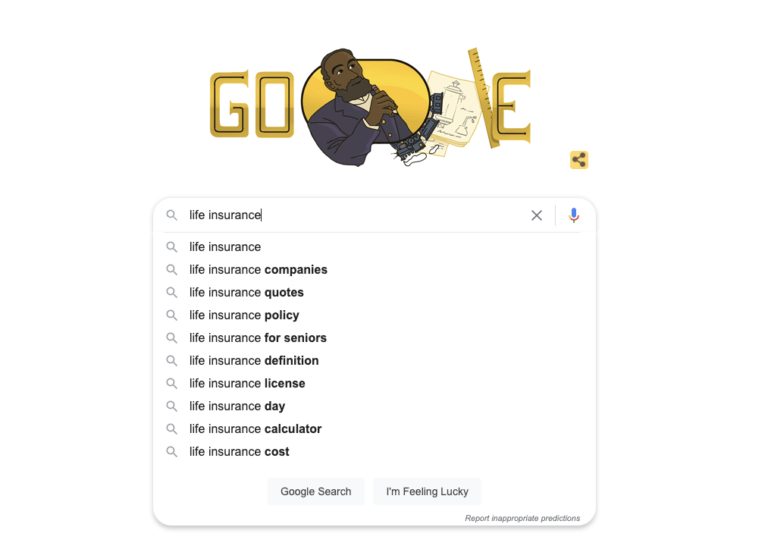 Screenshot from search for [life insurance], Google, May 2022
Screenshot from search for [life insurance], Google, May 2022
Let’s click through to see Google’s search results for our enterprise SEO keyword, “life insurance.”
There are paid ads at the top, followed by a sentence-structured featured snippet for Geico.com/life-insurance that defines what life insurance means and how it works.
-
 Screenshot from Google Search, May 2022
Screenshot from Google Search, May 2022
People Also Ask common questions are:
- What are the three main types of life insurance?
- What is life insurance and how does it work?
- What is the average life insurance cost per month?
- What is life insurance used for?
Knowing the recommended search terms and reading the PAA questions, we can conclude that people who search for [life insurance] want to know what life insurance is for and how much it costs.
Let’s see what we can learn from Geico’s featured snippet compared to competitors.
Links Review
Geico has 367 referring domains to the ranking page.
And has 155 of the 1,200 internal backlinks pointing to the ranking page, including “life insurance” in the anchor or surrounding text.
-
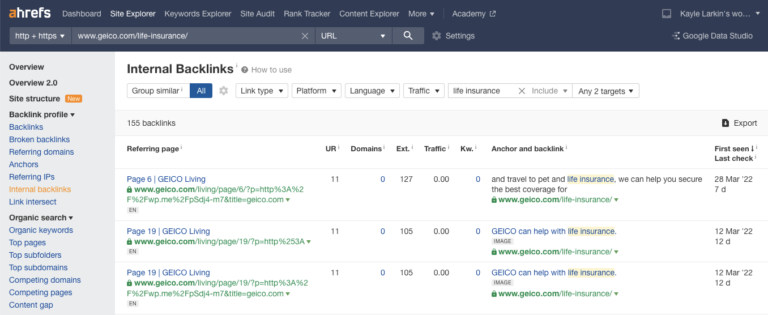 Screenshot from Ahrefs, May 2022
Screenshot from Ahrefs, May 2022
Investopedia is a contender for the top-ranking site and has significantly more referring domains than Geico or Liberty Mutual.
Significantly more, 1,100 referring domains versus Geico’s 367 and Liberty Mutual’s 300.
-
 Screenshot from Ahrefs, May 2022
Screenshot from Ahrefs, May 2022
Of Investopedia’s 726 internal backlinks, 711 are going to the ranking page, including the term “life insurance” in the anchor or surrounding text.
-
 Screenshot from Ahrefs, May 2022
Screenshot from Ahrefs, May 2022
Content Review
Geico’s home page H1 reads, “Life Insurance Quotes,” followed immediately by an H2 that reads, “See how affordable a life insurance policy can be.”
The first paragraph of the Geico web page addresses the primary question, “What is life insurance?” as an H2.
The paragraph leads off with “Life insurance is…,” and these first two sentences are pulled into the featured snippet for the life insurance search query.
-
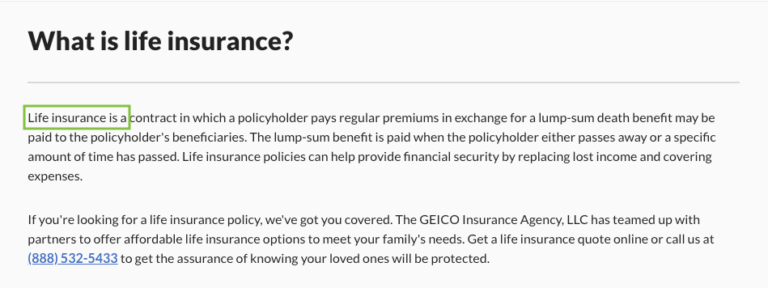 Screenshot from Geico website, May 2022
Screenshot from Geico website, May 2022
The term life insurance is used 49 times on the page with a total word count of 1922, which pales in comparison to Investopedia’s 5504 words!
Investopedia’s Page title is SEO perfection.
Note how it includes the keyword and its three support terms, life insurance, policies, and companies.
-
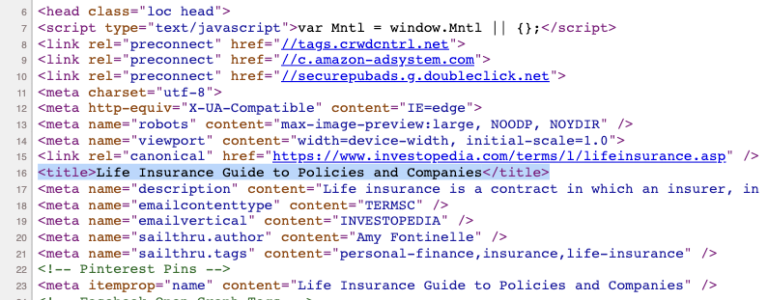 Screenshot from Investopedia page source, May 2022
Screenshot from Investopedia page source, May 2022
The page content starts with no introduction, just jumping right into an H1 “What is Life Insurance?
We find a definition for life insurance (just like Geico), “Life insurance is a contract between an insurer and a policy owner….”
-
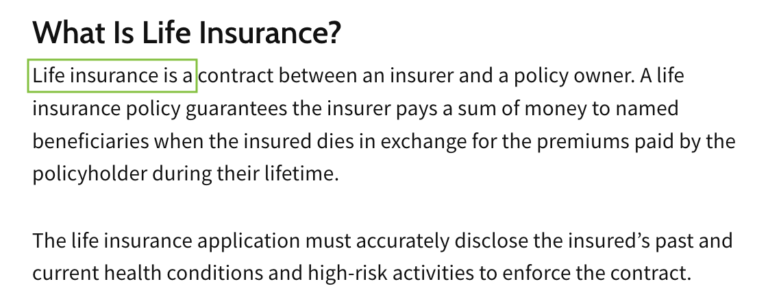 Screenshot from Investopedia web page, May 2022
Screenshot from Investopedia web page, May 2022
To highlight the pattern for this SERP a little bit more, I’m also showing you the fourth-ranking web page Liberty Mutual.
Just like Geico, Liberty Mutual stacks an H1 “Life Insurance” on top of an H2 “Ensure financial security for your family.”
Followed by a CTA box for starting a quote.
Scroll a bit further down the page and you will see an H2 for “What is a life insurance policy?”
Note that the header includes the additional word “policy.”
This approach didn’t pay off as Geico took the featured snippet for the search query, [What is a life insurance policy?] as well.
-
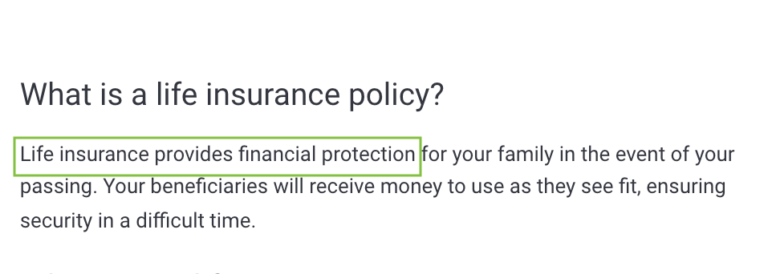 Screenshot from Liberty Mutual web page, May 2022
Screenshot from Liberty Mutual web page, May 2022
The trouble for Liberty Mutual is that the text following the H2 is not a definition.
It is sales language, explaining what the user gets when purchasing a life insurance policy.
Technical SEO/UX Review
Geico uses FAQ schema page markup for the accordion questions and answers at the bottom of the page.
This does not give the webpage a boost as it is not ranking on the first page for those queries.
Running the page path through Google’s page speed insights tool and Geico fails the core web vitals assessment.
Doing significantly poorly in the areas of first contentful paint (FCP) and largest contentful paint (LCP).
 Screenshot from Web Core Vitals Report, May 2022
Screenshot from Web Core Vitals Report, May 2022
Investopedia (position 2) uses article schema and passed core web vitals with all four areas in the green.
-
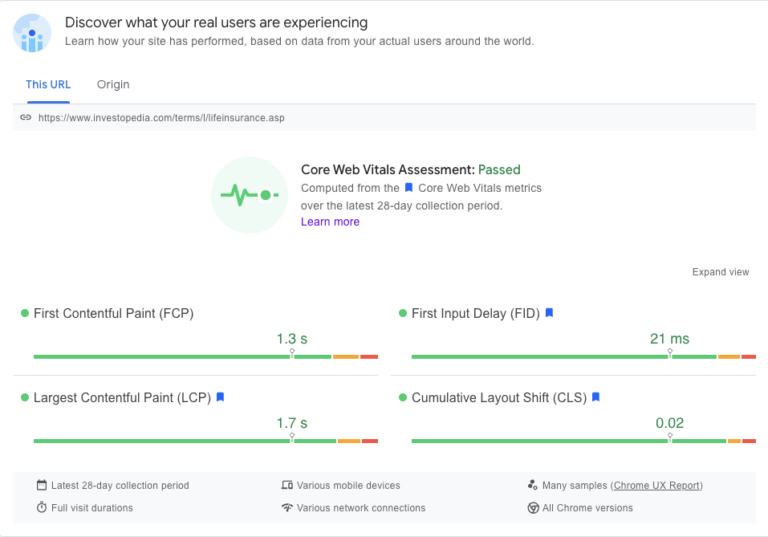 Screenshot from Web Core Vitals Report, May 2022
Screenshot from Web Core Vitals Report, May 2022
Liberty Mutual Insurance (position 4) uses breadcrumb and financial product schema. It passed the mobile core web vitals assessment by Google, with all four areas in the green.
-
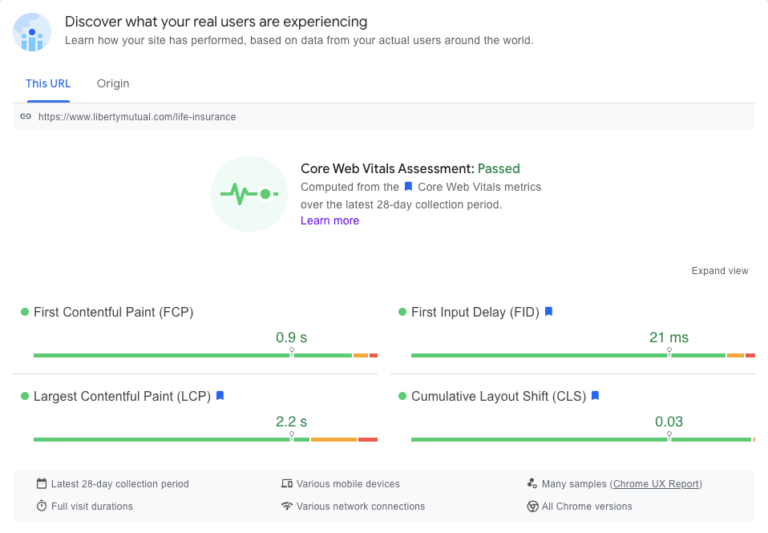 Screenshot from Web Core Vitals Report, May 2022
Screenshot from Web Core Vitals Report, May 2022
Life Insurance: What We Can Learn
By analyzing the featured snippet, we can see that the result Google is looking for is a definition.
The top-ranking pages all have the first H2 as “What is life insurance…” and the following subsequent text “Life insurance is (insert definition here.).”
Now, why is Geico outranking Investopedia when Investopedia is faster, and the quality of content is significantly better?
Well, step back and consider the singular web page in the context of Google’s full understanding of the website.
The Geico website is a company that sells insurance.
The Investopedia website educates consumers on all things related to finance.
Remember the common theme among related search queries and the PAA?
It gives us an additional hint about who people want to hear from when they search “life insurance.”
Google has determined that people want to know what life insurance is AND how much it costs.
Google has also determined that the closest recommended search query is “life insurance companies,” meaning that people are searching for:
- What life insurance is?
- How much does it cost?
- And for a company to purchase life insurance from.
It makes sense that Google would place a website that sells insurance above a website that provides information.
It would be interesting to see what happens if Investopedia places a form for life insurance quotes on its web page.
Or, if Liberty Mutual updated their definition for what life insurance is.
[NFT] SERP Insights
Crypto and NFT were two terms that had made it into the initial top 40 enterprise SEO keywords.
Given the virility of the queries, I had to include at least one in this review.
NFT had greater search volume, a higher difficulty rating, and a more interesting SERP.
Crypto.com was winning for “crypto.” Not much fun.
NFT Keyword Stats
- Average monthly search volume: 1.6M in the United States
- Difficulty rating: 96
- Average CPC: $1.10
-
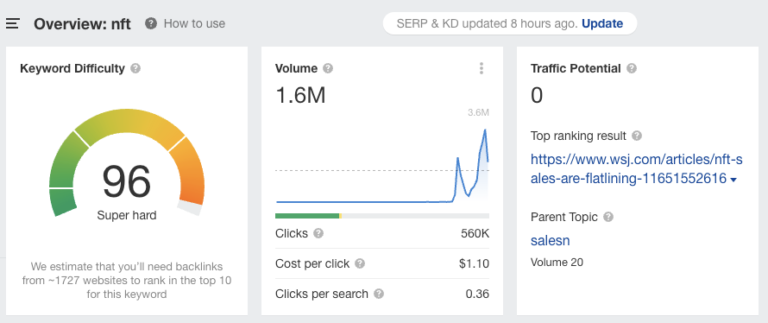 Screenshot from Ahrefs, May 2022
Screenshot from Ahrefs, May 2022
SERP Review
Google the acronym for a non-fungible token (NFT) and you’ll likely see something different depending on the day.
It’s a really volatile search with frequent position changes.
At the time of this analysis, there was a sentence-structure featured snippet by Reuters defining what NFTs are at the top of the SERP.
Note: The featured snippet changed hands three times as I wrote this article, and last I checked, it looks like the Wall Street Journal has since snagged the featured snippet.
Followed by a knowledge panel with information pulled from Wikipedia and “People also ask” questions:
- What is NFT and how does it work?
- What is NFT crypto?
- What does NFT stand for in NFT?
- What does it mean to own NFT?
-
 Screenshot from Google Search, May 2022
Screenshot from Google Search, May 2022
We can see that Google also (currently) thinks that users searching for [nft] are looking for a definition.
After the PAA, there are informational articles from news sites The Verge and Forbes.
The first company you will find is a marketplace, OpenSea.io.
The article by Forbes is of specific interest here because Forbes began ranking for the term “NFT” on April 9, 2022, after an update to the page made on April 8, 2022.
The kicker is the original article published on April 29, 2021.
Almost an entire year earlier.
So, what switch did Forbes flip?
-
 Screenshot from Forbes source code, May 2022
Screenshot from Forbes source code, May 2022
Links Review
Forbes has 2.31k referring domains and 16 internal backlinks pointing to the article, 14 including the term “nft” in the anchor or surrounding text.
All backlinks (from referring domains or internal pages) were added on or after April 8, 2022.
-
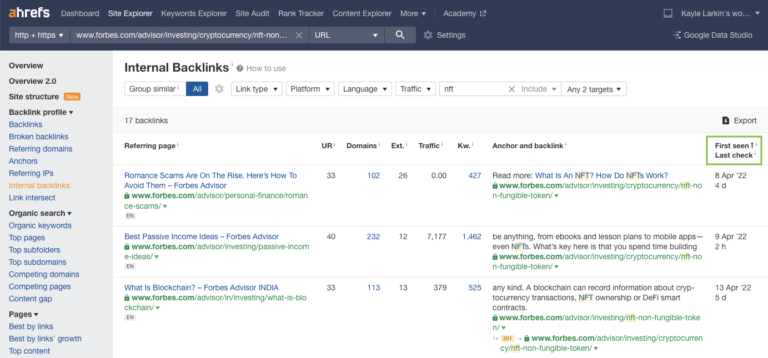 Screenshot from Ahrefs, May 2022
Screenshot from Ahrefs, May 2022
Content Review
I used the web page’s core web vitals to play “find the difference” and see if I could spot any of the edits to the content made on April 8th.
I didn’t see anything.
The page title, headers, and general page structure appear exactly the same.
And, it does not appear as though any edits were made to the Forbes article before April 2022.
-
 Screenshot from Wayback Machine, May 2022
Screenshot from Wayback Machine, May 2022
Tech SEO/UX Review
Forbes includes NewsArticle schema and failed core web vitals assessment by Google’s page speed insights tool.
It’s honestly really close to passing though, having passed FCP, LCP, and FID. Only failing cumulative layout shift (CLS).
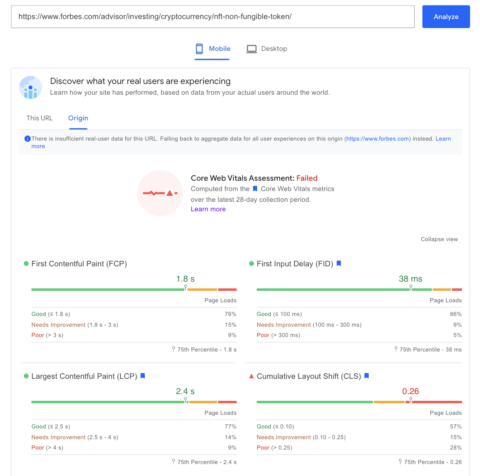 Screenshot from Web Core Vitals Report, May 2022
Screenshot from Web Core Vitals Report, May 2022What We Can Learn
In the case of Forbes’ article on NFTs, it appears that the article sat stale for nearly a year before getting the link love it needed to rank.
Don’t forget to link to your content! Google has confirmed that internal links are a ranking factor.
Final Thoughts
Google’s algorithm is constantly changing (thousands of times a year), so there’s no magic SEO formula or tool that can rank – and maintain the rank – of high-performance keywords.
By studying enterprise SEO wins, we can gather insights into how to best optimize our web pages:
- Analyze what Google has determined to be the user intent.
- Look for content opportunities left on the table.
- Use internal backlinks to tip the proverbial search result scales in your favor.
More resources:
Featured Image: G Stock Studio/Shutterstock
